清华大学:《分子生物学》课程PPT教学课件(基因ene)第二十八章 致癌基因和癌症(Oncogenes and cancer)
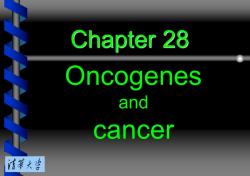
Chapter 28 Oncogenes and cancer 清第大当
Chapter 28 Oncogenes and cancer
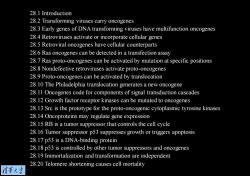
28.1 Introduction 28.2 Transforming viruses carry oncogenes 28.3 Early genes of DNA transforming viruses have multifunction oncogenes 28.4 Retroviruses activate or incorporate cellular genes 28.5 Retroviral oncogenes have cellular counterparts 28.6 Ras oncogenes can be detected in a transfection assay 28.7 Ras proto-oncogenes can be activated by mutation at specific positions 28.8 Nondefective retroviruses activate proto-oncogenes 28.9 Proto-oncogenes can be activated by translocation 28.10 The Philadelphia translocation generates a new oncogene 28.11 Oncogenes code for components of signal transduction cascades 28.12 Growth factor receptor kinases can be mutated to oncogenes 28.13 Sre is the prototype for the proto-oncogenic cytoplasmic tyrosine kinases 28.14 Oncoproteins may regulate gene expression 28.15 RB is a tumor suppressor that controls the cell cycle 28.16 Tumor suppressor p53 suppresses growth or triggers apoptosis 28.17 p53 is a DNA-binding protein 28.18 p53 is controlled by other tumor suppressors and oncogenes 28.19 Immortalization and transformation are independent 28.20 Telomere shortening causes cell mortality 清苇大兰
28.1 Introduction 28.2 Transforming viruses carry oncogenes 28.3 Early genes of DNA transforming viruses have multifunction oncogenes 28.4 Retroviruses activate or incorporate cellular genes 28.5 Retroviral oncogenes have cellular counterparts 28.6 Ras oncogenes can be detected in a transfection assay 28.7 Ras proto-oncogenes can be activated by mutation at specific positions 28.8 Nondefective retroviruses activate proto-oncogenes 28.9 Proto-oncogenes can be activated by translocation 28.10 The Philadelphia translocation generates a new oncogene 28.11 Oncogenes code for components of signal transduction cascades 28.12 Growth factor receptor kinases can be mutated to oncogenes 28.13 Src is the prototype for the proto-oncogenic cytoplasmic tyrosine kinases 28.14 Oncoproteins may regulate gene expression 28.15 RB is a tumor suppressor that controls the cell cycle 28.16 Tumor suppressor p53 suppresses growth or triggers apoptosis 28.17 p53 is a DNA-binding protein 28.18 p53 is controlled by other tumor suppressors and oncogenes 28.19 Immortalization and transformation are independent 28.20 Telomere shortening causes cell mortality
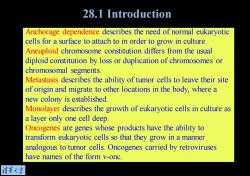
28.1 Introduction Anchorage dependence describes the need of normal eukaryotic cells for a surface to attach to in order to grow in culture Aneuploid chromosome constitution differs from the usual diploid constitution by loss or duplication of chromosomes or chromosomal segments. Metastasis describes the ability of tumor cells to leave their site of origin and migrate to other locations in the body,where a new colony is established. Monolayer describes the growth of eukaryotic cells in culture as a layer only one cell deep. Oncogenes are genes whose products have the ability to transform eukaryotic cells so that they grow in a manner analogous to tumor cells.Oncogenes carried by retroviruses have names of the form v-onc. 情華大当
Anchorage dependence describes the need of normal eukaryotic cells for a surface to attach to in order to grow in culture. Aneuploid chromosome constitution differs from the usual diploid constitution by loss or duplication of chromosomes or chromosomal segments. Metastasis describes the ability of tumor cells to leave their site of origin and migrate to other locations in the body, where a new colony is established. Monolayer describes the growth of eukaryotic cells in culture as a layer only one cell deep. Oncogenes are genes whose products have the ability to transform eukaryotic cells so that they grow in a manner analogous to tumor cells. Oncogenes carried by retroviruses have names of the form v-onc. 28.1 Introduction
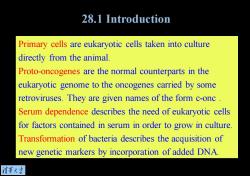
28.1 Introduction Primary cells are eukaryotic cells taken into culture directly from the animal. Proto-oncogenes are the normal counterparts in the eukaryotic genome to the oncogenes carried by some retroviruses.They are given names of the form c-onc. Serum dependence describes the need of eukaryotic cells for factors contained in serum in order to grow in culture. Transformation of bacteria describes the acquisition of new genetic markers by incorporation of added DNA. 清菜大当
Primary cells are eukaryotic cells taken into culture directly from the animal. Proto-oncogenes are the normal counterparts in the eukaryotic genome to the oncogenes carried by some retroviruses. They are given names of the form c-onc . Serum dependence describes the need of eukaryotic cells for factors contained in serum in order to grow in culture. Transformation of bacteria describes the acquisition of new genetic markers by incorporation of added DNA. 28.1 Introduction
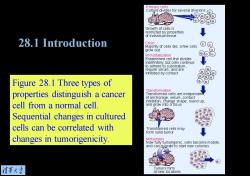
rimary cells Culture divides for several divisions @@60 Growth of cells is restricted by properties of individual tissue 28.1 Introduction Crisis Majority of cells die;a few cells grow out Immortalization Established cell line divides indefinitely,but cells continue to adhere to substratum. require serum,and are inhibited by contact Figure 28.1 Three types of 6S8 @⊙ properties distinguish a cancer Transfom ation Transfomed cells are independent of anchorage.serum,contact nhibiti on;change shape,round up. cell from a normal cell. and grow into a focus Sequential changes in cultured cells can be correlated with Transtormed cells may form solid tumor changes in tumorigenicity. Metastasis Now fully tumorigenic,cells become mobile and can migrate to start new colonies 情菜大学 Tumors form at new locations
Figure 28.1 Three types of properties distinguish a cancer cell from a normal cell. Sequential changes in cultured cells can be correlated with changes in tumorigenicity. 28.1 Introduction
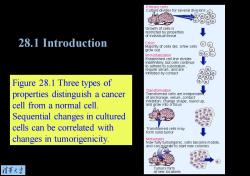
Primary cells Culture divides for several divisions Growth of cells is restricted by properties of individual tissue 28.1 Introduction Cnsis Majority of cells die;a few cells grow out Immortalization Established cell line divides indefinitely,but cells continue to adhere to substratum require serum,and are inhibited by contact Figure 28.1 Three types of properties distinguish a cancer Transfom ation Transfomed cells are independent of anchorage.serum.contact nhibiti on;change shape,round up cell from a normal cell and grow into a focus Sequential changes in cultured cells can be correlated with Transformed cells may form solid tumor changes in tumorigenicity. Metastasis Now fully tumorigenic,cells become mobile, and can migrate to start new colonies 清苇大当 Tumors form at new locations
Figure 28.1 Three types of properties distinguish a cancer cell from a normal cell. Sequential changes in cultured cells can be correlated with changes in tumorigenicity. 28.1 Introduction

28.1 Introduction Normal cells Transformed cells Figure 28.2 Normal fibroblasts grow as a layer of flat,spread-out cells,whereas transformed fibroblasts are rounded up and grow in cell masses.The cultures on the left contain normal cells,those on the right contain transformed cells.The top views are by conventional microscopy,the bottom by scanning electron microscopy. Photographskindly provided by Hidesaburo Hanafusa and J.Michael Bishop. 情菜大当
Figure 28.2 Normal fibroblasts grow as a layer of flat, spread-out cells, whereas transformed fibroblasts are rounded up and grow in cell masses. The cultures on the left contain normal cells, those on the right contain transformed cells. The top views are by conventional microscopy, the bottom by scanning electron microscopy. Photographs kindly provided by Hidesaburo Hanafusa and J. Michael Bishop. 28.1 Introduction
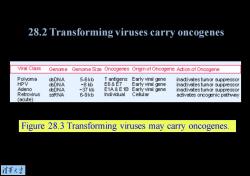
28.2 Transforming viruses carry oncogenes Viral Class Genome Genome Size Oncogenes Origin of Oncogene Action of Onoogene Polyoma dsDNA 5-6kh T antigens Early viral gene inadivates tumor suppressor HPV dsDNA ~8kb E6&E7 Early viral gene inadivates tumor suppressor Adeno dsDNA ~37 kb E1A E1B Early viral gene inadivates tumor suppressor Retrovirus SSRNA 6-9kh Individual Cellular adivates oncogenic pathay (acute) Figure 28.3 Transforming viruses may carry oncogenes. 清菜大当
Figure 28.3 Transforming viruses may carry oncogenes. 28.2 Transforming viruses carry oncogenes
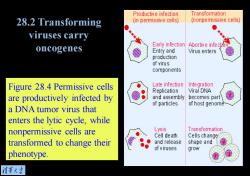
Productive infection Transformation 28.2 Transforming (in permissive cells) (nonpermissive cells) viruses carry Early infection Abortive infe ct oncogenes Entry and Virus enters production of virus components Figure 28.4 Permissive cells Late infection Integration Replication Viral DNA are productively infected by and assembly becomes part of particles of host genome a DNA tumor virus that enters the lytic cycle,while nonpermissive cells are Lysis Transformation Cell death Cells change transformed to change their and release shape and of viruses grow phenotype. 情菜大当
Figure 28.4 Permissive cells are productively infected by a DNA tumor virus that enters the lytic cycle, while nonpermissive cells are transformed to change their phenotype. 28.2 Transforming viruses carry oncogenes
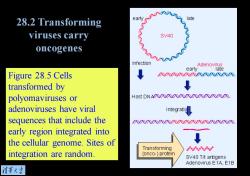
28.2 Transforming late viruses carry SV40 oncogenes 价ANN Infection Adenovirus early late Figure 28.5 Cells 入10707020八N风M八N transformed by ↓ polyomaviruses or HOSt DNAROCOUU入入NN adenoviruses have viral Integratig sequences that include the N入八N入八NNNN入N early region integrated into the cellular genome.Sites of Transforming ogog integration are random. (onco-)protein SV40 T/t antigens Adenovirus E1A,E1B 清第大兰
Figure 28.5 Cells transformed by polyomaviruses or adenoviruses have viral sequences that include the early region integrated into the cellular genome. Sites of integration are random. 28.2 Transforming viruses carry oncogenes
按次数下载不扣除下载券;
注册用户24小时内重复下载只扣除一次;
顺序:VIP每日次数-->可用次数-->下载券;
- 清华大学:《分子生物学》课程PPT教学课件(基因ene)第二十七章 细胞循环和生长调控(Cell cycle and growth regulation).ppt
- 清华大学:《分子生物学》课程PPT教学课件(基因ene)第二十六章 信号的传输(Signal transduction).ppt
- 清华大学:《分子生物学》课程PPT教学课件(基因ene)第二十五章 蛋白质间的开放交通(Protein trafficking).ppt
- 清华大学:《分子生物学》课程PPT教学课件(基因ene)第二十四章 免疫多样性(Immune diversity).ppt
- 清华大学:《分子生物学》课程PPT教学课件(基因ene)第二十三章 催化RNA(Catalytic RNA).ppt
- 清华大学:《分子生物学》课程PPT教学课件(基因ene)第二十二章 核的剪切(Nuclear splicing).ppt
- 清华大学:《分子生物学》课程PPT教学课件(基因ene)第二十一章 转录的调控(Regulation of Transcription).ppt
- 清华大学:《分子生物学》课程PPT教学课件(基因ene)第二十章 转录的起始(Initiation of transcription).ppt
- 清华大学:《分子生物学》课程PPT教学课件(基因ene)第十九章 核小体(Nucleosomes).ppt
- 清华大学:《分子生物学》课程PPT教学课件(基因ene)第十八章 染色体(Chromosomes).ppt
- 清华大学:《分子生物学》课程PPT教学课件(基因ene)第十七章 DNA的重新排列(Rearrangement of DNA).ppt
- 清华大学:《分子生物学》课程PPT教学课件(基因ene)第十六章 逆转录病毒和逆转座子(Retroviruses and retroposons).ppt
- 清华大学:《分子生物学》课程PPT教学课件(基因ene)第十五章 转座子(Transposons).ppt
- 清华大学:《分子生物学》课程PPT教学课件(基因ene)第十四章 重组和修复(Recombination and repair).ppt
- 清华大学:《分子生物学》课程PPT教学课件(基因ene)第十三章 DNA复制(DNA replication).ppt
- 清华大学:《分子生物学》课程PPT教学课件(基因ene)第十二章 复制子(The replicon).ppt
- 清华大学:《分子生物学》课程PPT教学课件(基因ene)第十一章 噬菌体的战略(Phage strategies).ppt
- 清华大学:《分子生物学》课程PPT教学课件(基因ene)第十章 操纵子(The operon).ppt
- 清华大学:《分子生物学》课程PPT教学课件(基因ene)第九章 转录(Transcription).ppt
- 清华大学:《分子生物学》课程PPT教学课件(基因ene)第八章 蛋白质定位(Protein localization).ppt
- 清华大学:《分子生物学》课程PPT教学课件(基因ene)第二十九章 梯度、级联和发信号的途径(Gradients, cascades, and signaling pathways).ppt
- 四川大学:《植物生物学》课程教学资源(教案讲义)第一章 植物的细胞和组织.pdf
- 四川大学:《植物生物学》课程教学资源(教案讲义)第二章 植物体的形态结构和发育.pdf
- 四川大学:《植物生物学》课程教学资源(教案讲义)第三章 植物的无机营养.pdf
- 四川大学:《植物生物学》课程教学资源(教案讲义)第四章 光合作用.pdf
- 四川大学:《植物生物学》课程教学资源(教案讲义)第五章 植物的繁殖.pdf
- 四川大学:《植物生物学》课程教学资源(教案讲义)第六章 植物的生长发育及其调控.pdf
- 四川大学:《植物生物学》课程教学资源(教案讲义)第七章 生物多样性和植物的分类及命名.pdf
- 四川大学:《植物生物学》课程教学资源(教案讲义)第八章 藻类植物.pdf
- 四川大学:《植物生物学》课程教学资源(教案讲义)第九章 苔藓植物.pdf
- 四川大学:《植物生物学》课程教学资源(教案讲义)第十章 蕨类植物.pdf
- 四川大学:《植物生物学》课程教学资源(教案讲义)第十一章 裸子植物.pdf
- 四川大学:《植物生物学》课程教学资源(教案讲义)第十二章 被子植物.pdf
- 《环境工程微生物学》课程教学资源(PPT课件)第一章 细菌结构与形态(1/2).ppt
- 《环境工程微生物学》课程教学资源(PPT课件)第一章 细菌结构与形态(2/2).ppt
- 《环境工程微生物学》课程教学资源(PPT课件)第二章 细菌的生理特性(1/5).ppt
- 《环境工程微生物学》课程教学资源(PPT课件)第二章 细菌的生理特性(2/5).ppt
- 《环境工程微生物学》课程教学资源(PPT课件)第二章 细菌的生理特性(3/5).ppt
- 《环境工程微生物学》课程教学资源(PPT课件)第二章 细菌的生理特性(4/5).ppt
- 《环境工程微生物学》课程教学资源(PPT课件)第二章 细菌的生理特性(5/5).ppt
